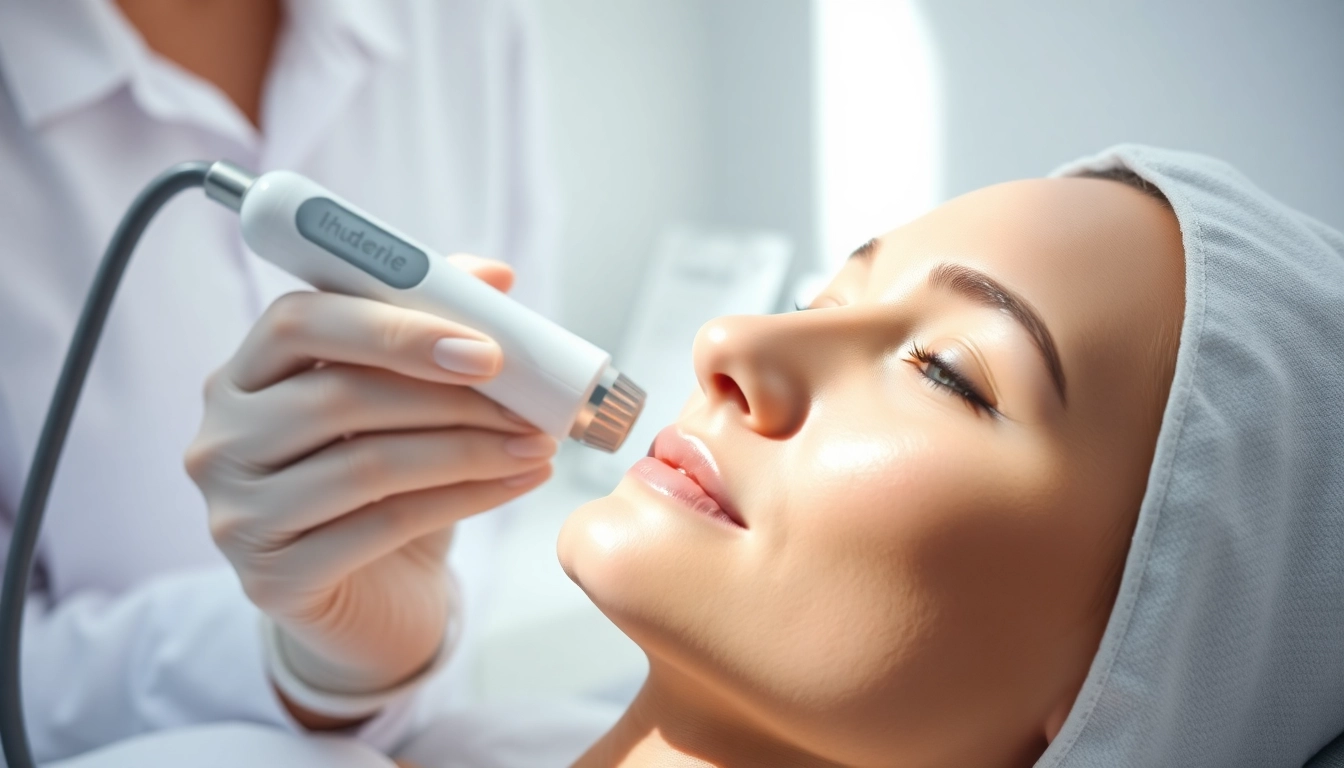Understanding RF microneedling
What is RF microneedling?
RF microneedling, or radiofrequency microneedling, is an advanced cosmetic procedure that combines traditional microneedling with the power of radiofrequency energy. This innovative treatment involves using thin, sterile needles to create micro-injuries in the skin, promoting the body’s natural healing processes. In parallel, radiofrequency energy is delivered through these needles, deeply penetrating the skin to stimulate collagen and elastin production. The combination of these two techniques results in improved skin texture, firmness, and overall tone.
Unlike conventional microneedling, which primarily focuses on surface-level skin rejuvenation, RF microneedling addresses deeper skin issues, making it an effective solution for various conditions, such as sagging skin, scars, and wrinkles. This hybrid approach has gained traction in the skincare community, touted for its efficacy and minimal downtime.
How RF microneedling works
The procedure utilizes a specialized device equipped with a series of tiny needles. When the device is pressed against the skin, the needles penetrate at precise depths, creating micro-channels in the dermis. Simultaneously, radiofrequency energy is released through these needles, generating thermal energy that heats the underlying tissues. This strategic heating encourages the production of collagen and elastin, essential components for youthful and resilient skin.
The heat generated by the radiofrequency also aids in tightening the skin by stimulating fibroblasts, the cells responsible for collagen production, leading to a noticeable improvement in skin elasticity. Moreover, this process helps to enhance overall skin rejuvenation, reducing fine lines and wrinkles while improving skin texture and tone.
Comparison with traditional microneedling
While both RF microneedling and traditional microneedling share the common goal of stimulating collagen production, they differ significantly in their methodology and results.
- Depth of Treatment: Traditional microneedling primarily targets the superficial layers of the skin, whereas RF microneedling penetrates deeper, addressing structural issues that can lead to sagging and loss of elasticity.
- Use of Energy: RF microneedling incorporates radiofrequency energy, which enhances the overall efficacy of the treatment by providing thermal stimulation to the dermis.
- Results: Patients often observe more significant and longer-lasting results with RF microneedling due to the combined effects of microneedling and radiofrequency energy.
- Recovery Time: Both methods offer minimal downtime; however, RF microneedling may necessitate slightly more recovery time due to the deeper penetration of the needles and the thermal effects of the radiofrequency energy.
Benefits of RF microneedling
Improving skin texture with RF microneedling
The skin’s texture can become uneven due to factors such as aging, sun exposure, and scarring. RF microneedling is formulated to transform the skin’s surface by reducing the appearance of enlarged pores, fine lines, and rough patches. The micro-injuries created during treatment stimulate the body’s healing response, enhancing cell turnover, which leads to a smoother and more refined skin texture.
Enhancing skin firmness and elasticity
As individuals age, their skin loses firmness and elasticity, contributing to sagging and the formation of wrinkles. RF microneedling combats these changes by invigorating the skin’s structural integrity. The heat from the radiofrequency energy tightens loose skin, while the stimulation of collagen and elastin production enhances skin resilience. As a result, patients often experience firmer, lifted skin that appears more youthful and vibrant.
Addressing scars and pigmentation issues
RF microneedling is particularly effective for patients dealing with acne scars, stretch marks, or other forms of skin discoloration. By promoting deeper collagen remodeling, this treatment helps to break down scar tissue and encourage the growth of new, healthy skin. Moreover, it can address pigmentation irregularities by promoting even skin tone, making it an ideal choice for individuals looking to improve their overall skin appearance.
The RF microneedling procedure
Pre-treatment consultation and assessments
Before undergoing RF microneedling, a thorough consultation with a qualified practitioner is essential. During this consultation, the practitioner will assess the patient’s skin type, medical history, and specific skin concerns to determine if they are a suitable candidate for the procedure. This step is crucial for establishing realistic expectations and creating a personalized treatment plan.
Step-by-step process of RF microneedling
The RF microneedling process typically involves the following steps:
- Preparation: The skin is cleansed to remove any impurities, and a topical anesthetic may be applied to minimize discomfort during the procedure.
- Procedure: The practitioner will utilize a specialized RF microneedling device to treat targeted areas of the skin. The depth of the needles can be adjusted to accommodate individual skin concerns.
- Radiofrequency Application: As the device penetrates the skin, it delivers controlled amounts of radiofrequency energy, stimulating collagen and elastin production.
- Post-Treatment Care: Following the procedure, patients will receive specific aftercare instructions to support optimal healing and results.
Aftercare and recovery tips
Post-treatment care is crucial for achieving the best results from RF microneedling. Patients should adhere to the following guidelines:
- Apply a gentle, soothing moisturizer to hydrate and protect the skin.
- Avoid direct sunlight, and use broad-spectrum sunscreen to prevent hyperpigmentation on treated areas.
- Stay hydrated to support the healing process.
- Refrain from using harsh skincare products, retinoids, or exfoliants for several days post-procedure.
- Attend follow-up appointments as recommended by the practitioner to monitor progress and results.
Potential side effects and considerations
Common side effects associated with RF microneedling
While RF microneedling is generally considered safe, some patients may experience mild side effects, including:
- Redness and swelling: Similar to a sunburn, these symptoms usually subside within a few hours to a few days.
- Minor discomfort or tenderness: Patients may feel sensitivity in the treated areas but typically tolerate it well.
- Bruising: In some cases, minor bruising can occur but should resolve quickly.
Who should avoid RF microneedling?
Despite its benefits, RF microneedling may not be suitable for everyone. Individuals who should avoid this procedure include:
- Those with active infections or skin conditions, such as eczema or psoriasis, in the treatment area.
- Pregnant or breastfeeding women, due to potential implications of the procedure on skin and hormonal changes.
- People with certain medical conditions, including autoimmune disorders, that may hinder the body’s healing response.
Long-term safety of RF microneedling
RF microneedling has been established as a safe procedure when performed by qualified practitioners. Long-term studies suggest that it can yield lasting results without significant adverse effects. However, patients must follow pre- and post-treatment guidelines to maximize safety and efficacy.
Is RF microneedling right for you?
Determining candidacy for RF microneedling
To determine if RF microneedling is right for you, consider your skincare goals, medical history, and current skin condition. A detailed consultation with a qualified professional is the best way to evaluate candidacy. Ideal candidates often express concerns related to skin texture, laxity, or scarring that respond well to this multifaceted approach.
Consultation: What to discuss with your practitioner
During your initial consultation, be prepared to discuss:
- Your skincare history, including previous treatments and their outcomes.
- Specific concerns about your skin and what you hope to achieve with RF microneedling.
- Any medications or supplements you are currently taking that may impact treatment.
- Your daily skincare routine and lifestyle factors that could influence healing and results.
Expected results and timelines after RF microneedling
Post-treatment results can typically be seen within a few weeks as collagen production ramps up and skin continues to regenerate. Optimal results may take a few months to fully manifest, as the skin undergoes continuous healing and renewal processes. Aftercare compliance is vital to achieving the best outcomes.
Patients commonly report improvements in skin texture, firmness, and overall appearance, contributing to a more youthful and rejuvenated look. Ongoing maintenance sessions can further enhance and prolong results, tailored to individual skin needs.



